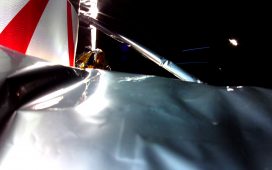High-powered radars, the end of floppy disks, defending hypersonic weapons and odd behavior by foreign satellites in space.
Readers of C4ISRNET found those subjects most engaging in 2019. But to anyone who closely follows the subject of battlefield technology, it shouldn’t come as a surprise.
Together, those topics cover the electromagnetic spectrum, IT modernization, emerging technologies and competition in space. In 2019, it was rare to hear a speech from a Pentagon leader that didn’t discuss at least one of those topics.
As the calendar year turns to 2020 and the fiscal year ticks forward another quarter, here’s a quick review of the stories readers of C4ISRNET spent the most time with:
One company claimed the F-35’s stealth cover was blown at a pony farm outside of Berlin. Now, German radar-maker Hensoldt claims to have tracked two F-35s for 150 kilometers following the 2018 Berlin Air Show. The company’s passive radar system, named TwInvis, is but one of an emerging generation of sensors and processors so sensitive and powerful that it promises to find previously undetectable activities in airspace.
At long last, the Strategic Automated Command and Control System or SACCS, has dumped the floppy disk, moving to a “highly secure solid state digital storage solution” in June, said Lt. Col. Jason Rossi, commander of the Air Force’s 595th Strategic Communications Squadron.
Think of SACCS as the U.S. nuclear force’s version of AOL instant messenger — one of the many old, duplicative systems used by U.S. Strategic Command to send emergency action messages from nuclear command centers to forces in the field.
“I joke with people and say it’s the Air Force’s oldest IT system. But it’s the age that provides that security,” Rossi said in an October interview. “You can’t hack something that doesn’t have an IP address. It’s a very unique system — it is old and it is very good.”
The Navy destroyer Thomas S. Hudner participated in a live-fire missile exercise using an Aegis “virtual twin” system, which the service is developing to significantly reduce the hardware footprint inside a ship needed to run the Aegis combat system.
When the Navy built its Arleigh Burke-class destroyers, installing the Aegis combat system into the hull required a large suite of hardware — computers, servers, consoles and displays — designed specifically to run Aegis software. Any significant upgrades to the suite of systems already installed, or to the Aegis system in general, required cutting a hole in the ship and swapping out computers and consoles — a massively expensive undertaking.
The virtual twin upends that model.
The Space Development Agency and the Missile Defense Agency have a plan: a proliferated low-Earth orbit constellation comprised of hundreds of satellites capable of detecting and tracking hypersonics. And Congress appears to be supportive of the concept. Both the House and Senate included $108 million for a hypersonic weapons tracking layer in space in the national defense policy bill, which was on the MDA’s list of unfunded priorities.
Some in the national security community believe a space sensor layer is the key to meeting the hypersonics threat, but what exactly is the hypersonic threat and how would a space sensor layer change things?
A Russian satellite has sidled up to yet another satellite in geostationary orbit, reigniting concerns that it could be stealing data or could cause a collision.
Since launching in September 2014, a Russian satellite known as Luch or Olymp has caused friction in the national security space community as it traverses across geostationary orbit. Geosynchronous satellites are separated into wide segments of space in order to avoid interference with each other, but Russian operators have ignored that setup with Luch, preferring instead to travel through the orbit, creeping up on other commercial and government satellites. By invading that space and snuggling up to another satellite, some worry Luch is theoretically able to intercept the ground signals directed at the targeted satellite, though it’s not clear from the limited amount of publicly available information if this is happening.






